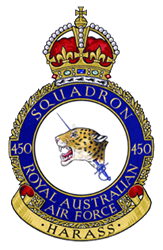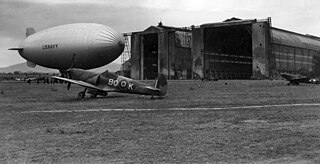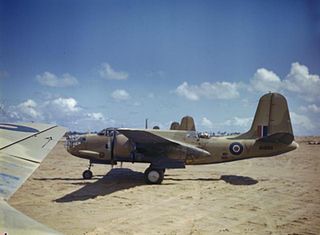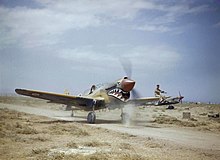
The Curtiss P-40 Warhawk is an American single-engined, single-seat, all-metal fighter-bomber that first flew in 1938. The P-40 design was a modification of the previous Curtiss P-36 Hawk which reduced development time and enabled a rapid entry into production and operational service. The Warhawk was used by most Allied powers during World War II, and remained in frontline service until the end of the war. It was the third most-produced American fighter of World War II, after the P-51 and P-47; by November 1944, when production of the P-40 ceased, 13,738 had been built, all at Curtiss-Wright Corporation's main production facilities in Buffalo, New York.

The RAF Third Tactical Air Force, which was formed in South Asia in December 1943, was one of three tactical air forces formed by the Royal Air Force (RAF) during the Second World War. It was made up of squadrons and personnel from the RAF, Indian Air Force (IAF) and the air forces of other Commonwealth countries. Third TAF was formed shortly after the establishment of South East Asia Command to provide close air support to the Fourteenth Army.

2 Squadron is a squadron in the South African Air Force which was formed in 1940. The squadron has a long history, having been involved in every single combat action in which the SAAF has taken part. During the Second World War it made a name for itself in the battles for East Africa, before distinguishing itself in North Africa as part of the Desert Air Force, and later in Italy.

1 Squadron SAAF was an air force squadron of the South African Air Force and was formed at Air Force Station Swartkop in February 1920, equipped with De Havilland DH.9's part of the Imperial Gift donation to South Africa by Britain. On 31 August 1939 the squadron was re-designated as 1 Bomber/Fighter Squadron and this was then changed to 11 (Bomber) Squadron in December 1939. The squadron was resurrected in February 1940 by the renumbering of 6 Squadron, equipped with four Hurricane Mk 1's and six Furies.

No. 3 Squadron is a Royal Australian Air Force (RAAF) fighter squadron, headquartered at RAAF Base Williamtown, near Newcastle, New South Wales. Established in 1916, it was one of four combat squadrons of the Australian Flying Corps during World War I, and operated on the Western Front in France before being disbanded in 1919. It was re-established as a permanent squadron of the RAAF in 1925, and during World War II operated in the Mediterranean Theatre. The Cold War years saw the squadron disbanded and re-raised twice. It was based at RAAF Butterworth during the Malayan Emergency and the Indonesia–Malaysia Konfrontasi. Equipped with McDonnell Douglas F/A-18 Hornet multi-role fighters from 1986, the squadron deployed to Diego Garcia in 2002 to provide local air defence, and the following year contributed aircraft and crews to the invasion of Iraq as part of Operation Falconer. In April 2016, it deployed to the Middle East as part of the military intervention against ISIL. The squadron began re-equipping with Lockheed Martin F-35 Lightning II multi-role fighters in 2018.

No. 450 Squadron was a unit of the Royal Australian Air Force (RAAF) that operated during World War II. Established at RAAF Station Williamtown, New South Wales, in February 1941, it was the first Australian Article XV squadron formed under the Empire Air Training Scheme.

No. 451 Squadron was a Royal Australian Air Force army cooperation and fighter squadron of World War II. It was formed at Bankstown, New South Wales, on 12 February 1941 and began flying operations on 1 July as part of the North African Campaign in Egypt and Libya. No. 451 Squadron was withdrawn for refitting in early January 1942 and spent the remainder of the year performing garrison duties in Syria. In January 1943, it was transferred to Egypt to contribute to local air defence but saw almost no combat. This inactivity caused morale among the squadron's personnel to greatly deteriorate.

Wilfred Stanley Arthur, was a fighter ace and senior officer of the Royal Australian Air Force (RAAF) during World War II. Commonly known as "Woof", he was officially credited with ten aerial victories. As a commander, he led combat formations at squadron and wing level, becoming at twenty-four the youngest group captain in the history of the RAAF.

Northwest African Air Forces (NAAF) was a component of the Allied Mediterranean Air Command (MAC) during February–December 1943. It was responsible primarily for air operations during the Tunisian Campaign and bombing of Italy. Its commander was Lieutenant General Carl Spaatz of the United States Army Air Force. NAAF was created following a reorganization of the command structure of Allied air forces in the Mediterranean Theatre. The other components of MAC were Middle East Command (MEC), AHQ Malta, RAF Gibraltar and 216 Group.
The Northwest African Tactical Air Force (NATAF) was a component of the Northwest African Air Forces which itself reported to the Mediterranean Air Command (MAC). These new Allied air force organizations were created at the Casablanca Conference in January 1943 to promote cooperation between the British Royal Air Force (RAF), the American United States Army Air Force (USAAF), and their respective ground and naval forces in the North African and Mediterranean theater of World War II. Created on February 18, 1943, the NATAF and other MAC commands existed until December 10, 1943, when MAC was disbanded and the Mediterranean Allied Air Forces (MAAF) were established.

Air Headquarters Malta was an overseas command of the Royal Air Force (RAF) during the Second World War. It was established on 28 December 1941 by renaming RAF Mediterranean under Air Vice Marshal Hugh Lloyd. Lloyd was named Air Officer Commanding in Malta on 1 June 1941.

No. 211 Group RAF is a former Royal Air Force group which disbanded in September 1943. It initially formed in December 1941, then disbanded in February 1942. The group immediately reformed in March 1942 as No. 211 Group within RAF Middle East Command.

Peter Jeffrey, was a senior officer and fighter ace in the Royal Australian Air Force (RAAF). Born in Tenterfield, New South Wales, he joined the RAAF active reserve in 1934, and transferred to the Permanent Air Force (PAF) shortly before World War II. Posted to the Middle East in July 1940, Jeffrey saw action with No. 3 Squadron and took command of the unit the following year, earning the Distinguished Flying Cross for his energy and fighting skills. He was appointed wing leader of No. 234 Wing RAF in November 1941, and became an ace the same month with his fifth solo victory. The next month he was awarded the Distinguished Service Order for his achievements, which included rescuing a fellow pilot who had crash landed in the desert.

4 Squadron SAAF was a South African Air Force unit which served during World War II.
The History of the South African Air Force spans the First World War, Rand Rebellion of 1922, the Second World War, the Korean War, the South African Border War, and varied peacekeeping operations since 1994. Its battle honours include German South West Africa 1914–15, German East Africa 1915–1918, East Africa: 1939–1941, Middle East: 1941–43, Madagascar 1942, Italy 1943–1945, the Balkans 1943–1945, and Korea 1950–1953.

No. 3 (S.A.) Wing was a South African Air Force commanded formation during World War II that served in North Africa, Sicily and Italy. The formation was recommended by HQ RAF Middle East on 28 October 1941 to the Air Ministry and authorised by AIR54/96 on 3 November 1941. The Wing initially consisted of Royal Air Force and South African Air Force squadrons under South African command: No. 11 Squadron RAF and No. 113 Squadron RAF with Bristol Blenheim bombers and fighters and No. 12 Squadron SAAF, No. 21 Squadron SAAF (both with Martin Maryland bombers and No. 24 Squadron SAAF with Douglas Boston bombers. The latter unit was re-assigned to Army Cooperation before the start of Operation Crusader while No. 113 Squadron was assigned to Whitforce. This left 12, 21 Squadrons SAAF plus No. 11 Squadron RAF as its assigned units, with additional units being assigned later. Two RAF squadrons left for the Far East when Japan declared war in December 1941.

North-Western Area Command was one of several geographically based commands raised by the Royal Australian Air Force (RAAF) during World War II. Its wartime sphere of operations included the Northern Territory, adjacent portions of Queensland and Western Australia, and the Dutch East Indies. The command was formed in January 1942, following the outbreak of the Pacific War, from the western part of Northern Area Command, which had covered all of northern Australia and Papua. Headquartered at Darwin, North-Western Area Command was initially responsible for air defence, aerial reconnaissance and protection of the sea lanes within its boundaries.

Alan Charles Rawlinson, was an Australian airman who became a fighter ace in World War II. He was credited with at least eight aerial victories, as well as two aircraft probably destroyed, and another eight damaged.

No. 8 Wing SAAF was a South African Air Force commanded formation during World War II that served in Italy, the Balkans and the Mediterranean Theatre. It was formed on 25 July 1944 and consisted of Royal Air Force and South African Air Force squadrons under South African command. MAAF on 13 June 1944 asked the SAAF to reman immediately a new defensive fighter wing HQ to embrace No. 3 Squadron, No. 11 Squadron and No. 41 Squadron. By 22 June the request had been approved. Col "Rosy" du Toit opened the new office for the Wing in the SAAF Headquarters building in Bari on 16 July 1944. HQ 8 Wing would also take control of No. 87 Squadron RAF and No. 185 Squadron RAF Lt-Col D.D. "Snowy" Moodie was appointed Sweep Leader of the new Wing. On 25 July 8 Wing came under administrative control of Desert Air Force. 8 Wing Headquarters moved from Foiano to Borghetto on 10 September 1944. where the two RAF squadrons joined the Wing, together with RAF No. 53 RSU. By the end of September, a it became clear that the end of the war was not at hand, the SAAF had two fighter-bomber Wing operating in Europe simultaneously for the first time.






















